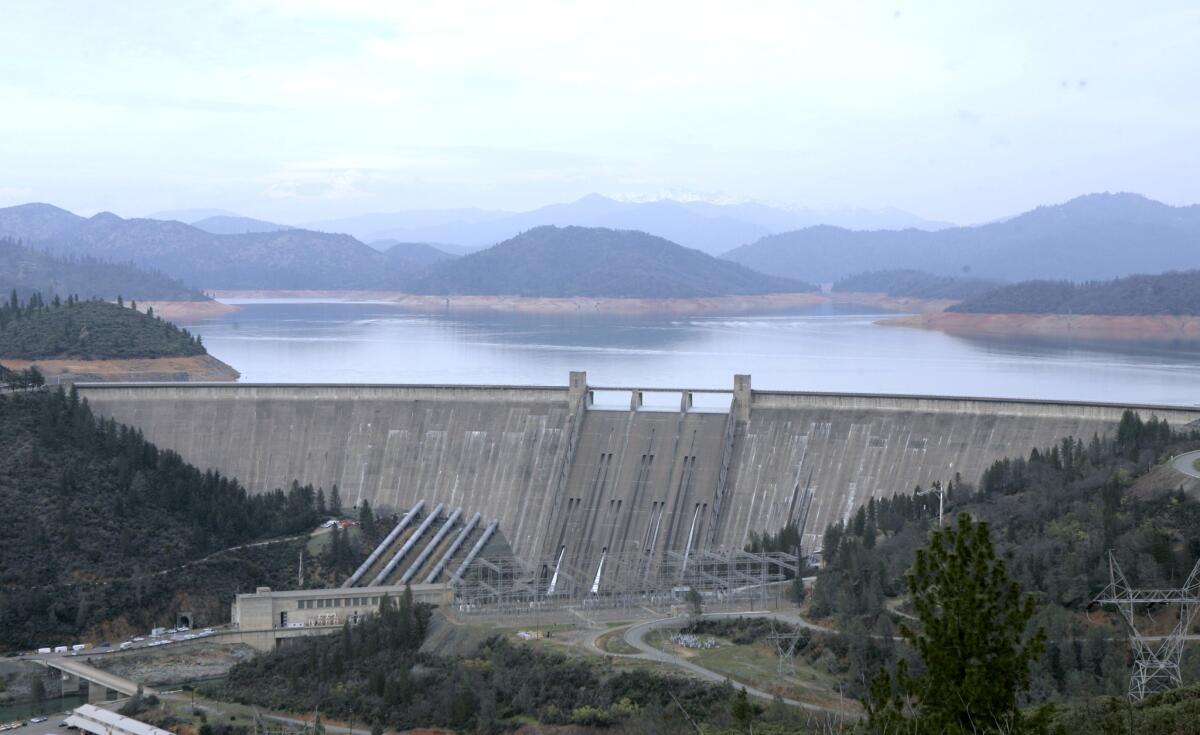Op-Ed: The water revolution California needs

This year’s drought has thrown California into a sudden tizzy, a crisis of snowpack measurements, fish-versus-people arguments and controversial cuts in water deliveries. But in reality, crisis is the permanent state of water affairs in the Golden State — by design, because our institutions keep it that way.
California has 1,400 major dams, thousands of miles of aqueducts and pumps so powerful they lift water nearly 2,000 feet over the Tehachapis. The state uses enough water in an average year to support, in theory, 318 million Californians (and their lawns and dishwashers), more than eight times the actual population of 38 million.
Even with the gargantuan re-engineering of nature, there is never enough water. How could there be, when according to the calculations of fishing and environmental advocates, the state has granted more than five times as many water rights claims as there is water in our main rivers, even in a good year? When our Gold Rush-era laws all but compel water-rights holders to use as much water as they can, as fast as possible, lest they lose their entitlements?
Basic economics tells us that a precious commodity should be priced accordingly and directed toward high-value uses. Instead, California does the opposite with its water resources. About 75% of water used in the state goes to agriculture. California is the top agriculture producer in the United States, but ag contributes just 2% to the state’s economic output.
Economics also says that rarity promotes efficiency. But nearly half of California farms still use flood irrigation, when using sprinklers or drip systems could save nearly as much water every year as the 9 million acre-feet all 38 million of us use.
Many of these farmers have little incentive to upgrade their systems, when water is provided to them at a discount through direct subsidies, interest exemptions, writing-off part of the cost of dams and the use of cheap hydropower from those dams. On top of this, urban ratepayers foot more than their share of water projects that benefit agriculture as well.
Worse, when drought crimps surface supplies in rivers and reservoirs, California water users turn to pumping groundwater. The predictable result has been plummeting water tables, land subsidence, skyrocketing well drilling costs and further drying of streams connected to groundwater.
The cost to our environment is steep. California’s salmon and steelhead populations are either extinct, endangered or in decline. The Sacramento-San Joaquin River Delta, switching yard for most of the state’s water supplies, is close to ecological collapse because too much water is pumped out of it or is diverted before it gets there.
The primary response of the governor and state agencies has been to demand more subsidized mega-projects, while failing to fundamentally reform a flawed and failing system.
Instead, California ought to learn from the experience of Australia, the driest continent on Earth, with a broadly similar economy, climate and, until recently, a similarly balkanized and economically irrational water management system. Faced with a 12-year-long drought, which brought fatal brush fires to its cities and devastation to its agricultural communities, Australia’s state and federal governments agreed in 2007 to manage their water “in the national interest rather than on jurisdictional or sectoral based views,” in the words of the federal environment minister.
Beginning with Australia’s largest river system, the Murray-Darling basin, planners and scientists now look first to how much water is needed to sustain stream ecosystems, and cap diversions to maintain them. Water quality, salinity and the connections between surface and ground water are all taken into account. Next, water is set aside for the essential needs of human communities for drinking, household use, sanitation and firefighting.
Above these baselines, water can safely be diverted for other, economic uses. Cuts to historic diversion levels have been cushioned by billions in government funding to buy water rights from willing sellers and make investments in efficiency such as canal lining, drip and computerized irrigation, and increased water storage. Subsidies have been eliminated, so the full cost of infrastructure is paid by its users.
Crucially, barriers to water trading were removed, allowing water to flow to higher-value, more efficient uses, while compensating sellers. Water rights were converted to “shares,” whose amount and value fluctuate along with natural conditions. Farmers with “interruptible” crops, such as rice, which is planted every year, sell water in dry times, while farmers with permanent crops, like orchards, or the most lucrative crops buy it.
So far, Australia’s new water market has performed as economists predicted: Even in the worst year of the drought, with delivery cuts of two-thirds, the value of agricultural production remained 70% of normal, according to Mike Young, professor at the University of Adelaide. Initially, water prices soared, but they have since fallen back as farmers and urban users have learned to do more with less. Australia’s cities, already relatively frugal, cut their use by 35% to 50%. Fearof hoarding by outside investors and market manipulation proved overblown, but California ought to take these potential pitfalls into account in designing its own water markets.
As in Australia, drought is normal in California, in one of the most variable climates on Earth. Instead of pursuing unrealistic “coequal goals” of simultaneous environmental health and water supply “reliability” — as mandated for the delta — our water management system ought to be based on adapting to an unreliable climate, protecting our environment and communities first while increasing economic efficiency, and ending, not creating, a state of crisis.
Wade Graham is an adjunct professor of public policy at Pepperdine University, a trustee of the Glen Canyon Institute and the author of “American Eden.”
More to Read
Sign up for Essential California
The most important California stories and recommendations in your inbox every morning.
You may occasionally receive promotional content from the Los Angeles Times.










